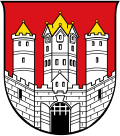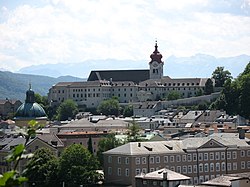This article needs additional citations for verification .(June 2023) |
Salzburg | |
|---|---|
Roittner-Durchhaus | |
| Coordinates: 47°48′00″N13°02′42″E / 47.80000°N 13.04500°E | |
| Country | |
| State | Salzburg |
| District | Statutory city |
| Government | |
| • Mayor | Bernhard Auinger (SPÖ) |
| Area | |
• Total | 65.65 km2 (25.35 sq mi) |
| Elevation | 424 m (1,391 ft) |
| Population (1 October 2020) [2] | |
• Total | 157,245 |
| • Density | 2,395/km2 (6,204/sq mi) |
| Demonym(s) | English: Salzburger or Salzburgian German: Salzburger (m.), Salzburgerin (f.) |
| Time zone | UTC+1 (CET) |
| • Summer (DST) | UTC+2 (CEST) |
| Postal code | 5020 |
| Area code | 0662 |
| Vehicle registration | S |
| Website | www |
| UNESCO World Heritage Site | |
|---|---|
 | |
 Interactive map of Historic Centre of the City of Salzburg | |
| Criteria | Cultural: ii, iv, vi |
| Reference | 784 |
| Inscription | 1996 (20th Session) |
| Area | 236 ha (580 acres) |
| Buffer zone | 467 ha (1,150 acres) |
Salzburg [a] is the fourth-largest city in Austria. In 2020 its population was 156,852. [7] The city lies on the Salzach River, near the border with Germany and at the foot of the Alps mountains.
Contents
- Etymology
- History
- Antiquity
- Middle Ages
- Under the prince-bishopric's rule
- Modern era
- Electorate of Salzburg
- Austrian and Bavarian rule
- 20th century
- Geography
- Climate
- Demography
- History 2
- Migrant communities
- Architecture
- Romanesque and Gothic
- Renaissance and baroque
- Classical modernism and post-war modernism
- Contemporary architecture
- Districts
- Main sights
- Education
- Universities and higher education institutions
- Notable citizens
- Events
- Transport
- Popular culture
- Language
- Sports
- Football
- Ice hockey
- Other sports
- International relations
- Twin towns—sister cities
- Gallery
- See also
- Notes
- References
- Bibliography
- External links
The town occupies the site of the Roman settlement of Iuvavum. Founded as an episcopal see in 696, it became a seat of the archbishop in 798. Its main sources of income were salt extraction, trade, as well as gold mining. The fortress of Hohensalzburg, one of the largest medieval fortresses in Europe, dates from the 11th century. In the 17th century, Salzburg became a centre of the Counter-Reformation, with monasteries and numerous Baroque churches built. Salzburg has an extensive cultural and educational history, being the birthplace of Wolfgang Amadeus Mozart and being home to three universities and a large student population. Today, along with Vienna and the Tyrol, Salzburg is one of Austria's most popular tourist destinations. [8]
Salzburg's historic center (German : Altstadt) is renowned for its Baroque architecture and is one of the best-preserved city centres north of the Alps. The historic center was listed as a UNESCO World Heritage Site in 1996. [9]


















































